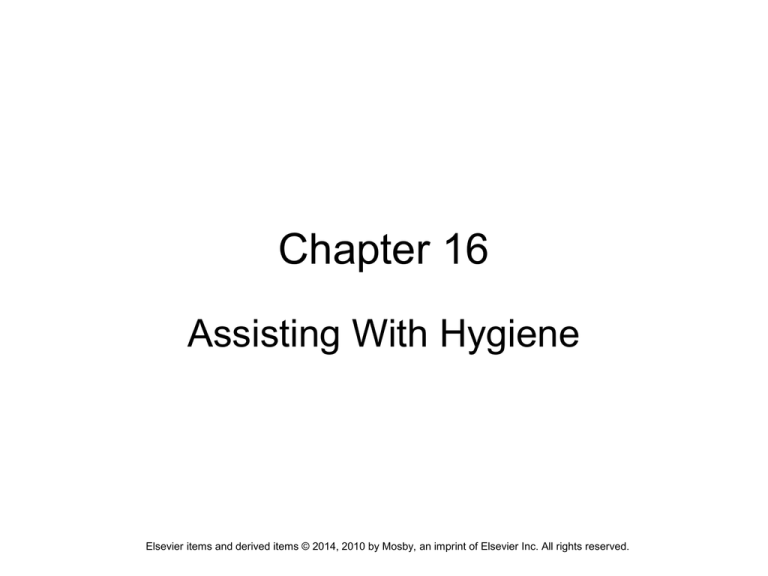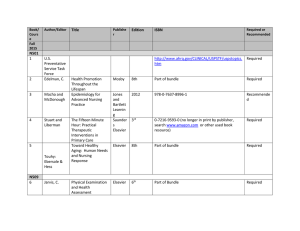Chapter 16 Hygiene
advertisement

Chapter 16 Assisting With Hygiene Elsevier items and derived items © 2014, 2010 by Mosby, an imprint of Elsevier Inc. All rights reserved. Hygiene Basics The skin is the body’s first line of defense against disease. Good hygiene: Intact skin prevents microbes from entering the body and causing an infection. Cleanses the skin and mucous membranes Prevents body and breath odors Is relaxing and increases circulation Culture and personal choice affect hygiene. Elsevier items and derived items © 2014, 2010 by Mosby, an imprint of Elsevier Inc. All rights reserved. 2 Daily Care Most people have hygiene routines and habits. You assist with hygiene whenever it is needed. Protect the right to privacy and to personal choice. Routine care is given during the day and evening. Routine care given before breakfast is called early morning care or AM care. Morning care is given after breakfast. Afternoon care is given after lunch and before the evening meal. Care given in the evening at bedtime is called evening care or PM care. Elsevier items and derived items © 2014, 2010 by Mosby, an imprint of Elsevier Inc. All rights reserved. 3 Oral Hygiene Oral hygiene (mouth care) does the following: Keeps the mouth and teeth clean Prevents mouth odors and infections Increases comfort Makes food taste better Reduces the risk for cavities (dental caries) and periodontal disease (gum disease, pyorrhea) Elsevier items and derived items © 2014, 2010 by Mosby, an imprint of Elsevier Inc. All rights reserved. 4 Oral Hygiene, cont’d. Flossing does the following: Removes food from between the teeth Removes plaque and tartar • Plaque and tartar cause periodontal disease. You may have to perform oral hygiene for persons who: Are very weak Cannot move or use their arms Are too confused to brush their teeth Elsevier items and derived items © 2014, 2010 by Mosby, an imprint of Elsevier Inc. All rights reserved. 5 Oral Care for the Unconscious Person Mouth care for the unconscious person Unconscious persons may have mouth dryness and crusting on the tongue and mucous membranes. The care plan tells you what cleaning agent to use. • Use sponge swabs to apply the cleaning agent. To prevent cracking of the lips, apply a lubricant to the lips after cleaning. • Check the care plan. Protect unconscious persons from choking and aspiration. • Aspiration is breathing fluid, food, vomitus, or an object into the lungs. Elsevier items and derived items © 2014, 2010 by Mosby, an imprint of Elsevier Inc. All rights reserved. 6 Oral Care for the Unconscious Person, cont'd. To prevent aspiration: Keep the person’s mouth open with a padded tongue blade. Unconscious persons cannot speak or respond to you. Position the person on one side with the head turned well to the side. Use only a small amount of fluid to clean the mouth. Do not insert dentures. Always assume that unconscious persons can hear. Explain what you are doing step by step. Mouth care is given at least every 2 hours. Follow the nurse’s directions and the care plan. Elsevier items and derived items © 2014, 2010 by Mosby, an imprint of Elsevier Inc. All rights reserved. 7 Denture Care Denture care A denture is an artificial tooth or a set of artificial teeth. Mouth care is given and dentures cleaned as often as natural teeth. Dentures are slippery when wet. Hold them firmly. To use a cleaning agent, follow the manufacturer’s instructions. Hot water causes dentures to lose their shape (warp). Remind patients and residents not to wrap dentures in tissues or napkins. Elsevier items and derived items © 2014, 2010 by Mosby, an imprint of Elsevier Inc. All rights reserved. 8 Bathing Bathing has the following benefits: It cleans the skin. It cleans the mucous membranes of the genital and anal areas. • Microbes, dead skin, perspiration, and excess oils are removed. A bath is refreshing and relaxing. Circulation is stimulated and body parts exercised. Observations are made. You have time to talk to the person. Elsevier items and derived items © 2014, 2010 by Mosby, an imprint of Elsevier Inc. All rights reserved. 9 Bathing, cont'd. Complete or partial baths, tub baths, or showers are given. The method depends on: • The person’s condition • Self-care abilities • Personal choice Personal choice, weather, activity, and illness affect bathing frequency. The care plan tells you when to bathe the person. Elsevier items and derived items © 2014, 2010 by Mosby, an imprint of Elsevier Inc. All rights reserved. 10 Bathing, cont'd. The complete bed bath involves washing the person’s entire body in bed. Bed baths are usually needed by persons who are: • • • • Unconscious Paralyzed In casts or traction Weak from illness or surgery The partial bath involves bathing the face, hands, axillae (underarms), back, buttocks, and perineal area. Some persons bathe themselves in bed or at the sink. You assist or give partial baths as needed. Elsevier items and derived items © 2014, 2010 by Mosby, an imprint of Elsevier Inc. All rights reserved. 11 Tub Baths and Showers Falls, burns, and chilling from water are risks. Tub baths are relaxing. A tub bath lasts no longer than 20 minutes. Showers If persons can stand, they use the grab bars for support during the shower. Showers have non-skid surfaces or a bath mat is used. Never let weak or unsteady persons stand in the shower. Some shower rooms have two or more stations. • Protect the person’s privacy. Elsevier items and derived items © 2014, 2010 by Mosby, an imprint of Elsevier Inc. All rights reserved. 12 Perineal Care Perineal care (pericare) involves cleaning the genital and anal areas. Cleaning prevents infection and odors, and it promotes comfort. Perineal care is done: Daily during the bath Whenever the area is soiled with urine or feces Elsevier items and derived items © 2014, 2010 by Mosby, an imprint of Elsevier Inc. All rights reserved. 13 Perineal Care, cont'd. Perineal care is very important for persons who: Have urinary catheters Have had rectal or genital surgery Have given birth Are menstruating Are incontinent of urine or feces Are uncircumcised The person does perineal care if able. Elsevier items and derived items © 2014, 2010 by Mosby, an imprint of Elsevier Inc. All rights reserved. 14 Perineal Care, cont'd. When giving perineal care, Standard Precautions, medical asepsis, and the Bloodborne Pathogen Standard are followed. Work from the cleanest area to the dirtiest. When giving perineal care: Use warm water, not hot. Use washcloths, towelettes, cotton balls, or swabs according to agency policy. Rinse thoroughly. Pat dry after rinsing. Elsevier items and derived items © 2014, 2010 by Mosby, an imprint of Elsevier Inc. All rights reserved. 15

